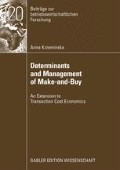Abstract
In his pivotal article from 1937, Coase questions the reason why organizations exist at all, since resources are ostensibly allocated most efficiently by the price mechanism of the market (Coase, 1937:388). He argues that markets and hierarchies were equivalent institutional arrangements to carrying out a transaction, if they would not entail different costs (Coase, 1937:388-392). Therefore “[T] he main reason why it is profitable to establish a firm would seem to be that there is a cost of using the price mechanism” (Coase, 1937:390). With this argumentation, Coase contributes to economic theory in a great manner: The distinction between market and hierarchy can be understood as two categories of possible ways of organizing economic transactions, whose favorability is determined by the costs they cause. “[A]s categories come to be defined in terms of different situations in which practitioners might find themselves” (Christensen et al., 2001:11), the costs which arise when using the price mechanism (market), respectively authority (hierarchy)represent such different situations and are as a result the circumstances to distinguish between the two categories market and hierarchy.
Access this chapter
Tax calculation will be finalised at checkout
Purchases are for personal use only
Preview
Unable to display preview. Download preview PDF.
o
Bradach, J. L., Eccles, R. G.(1989). Price, Authority, and Trust: From Ideal Types to Plural Forms, Annual Review of Sociology, 15: 97–118.
Bradach, J. L.(1997). Using the plural form in the management of restaurant chains, Administrative Science Quarterly, 42(2): 276–303.
Williamson, O. E. (1985). The Economic Institutions of Capitalism: Firms, Markets, Relational Contracting, New York, London.
Mols, P. M. (2000). Dual channels of distribution: a transaction cost analysis and propositions, International Review of Retail, Distribution, and Consumer Research, 10(3): 227–246.
Dutta, S., Bergen, M., Heide, J.B., and John, G. (1995). Understanding Dual Distribution: The Case of Reps and House Accounts, The Journal of Law, Economics and Organization, 11(1): 189–204.
Parmigiani, A. E. (2003). Concurrent sourcing: When do firms both make and buy?. PhD Dissertation, Michigan, University of Michigan.
Parmigiani, A. E. (2007). Why do firms both make and buy?, Strategic Management Journal, 28(3): 285–311.
Mellewigt, T. (2003). Management von Strategischen Kooperationen.Wiesbaden. 9
Bradach, J.L.(1997). Using the plural form in the management of restaurant chains, Administrative Science Quarterly, 42(2): 276–303.
Rights and permissions
Copyright information
© 2008 Gabler | GWV Fachverlage GmbH, Wiesbaden
About this chapter
Cite this chapter
(2008). The Logic of Economic Organization. In: Determinants and Management of Make-and-Buy. Gabler. https://doi.org/10.1007/978-3-8349-9924-5_2
Download citation
DOI: https://doi.org/10.1007/978-3-8349-9924-5_2
Publisher Name: Gabler
Print ISBN: 978-3-8349-1275-6
Online ISBN: 978-3-8349-9924-5
eBook Packages: Business and EconomicsBusiness and Management (R0)

